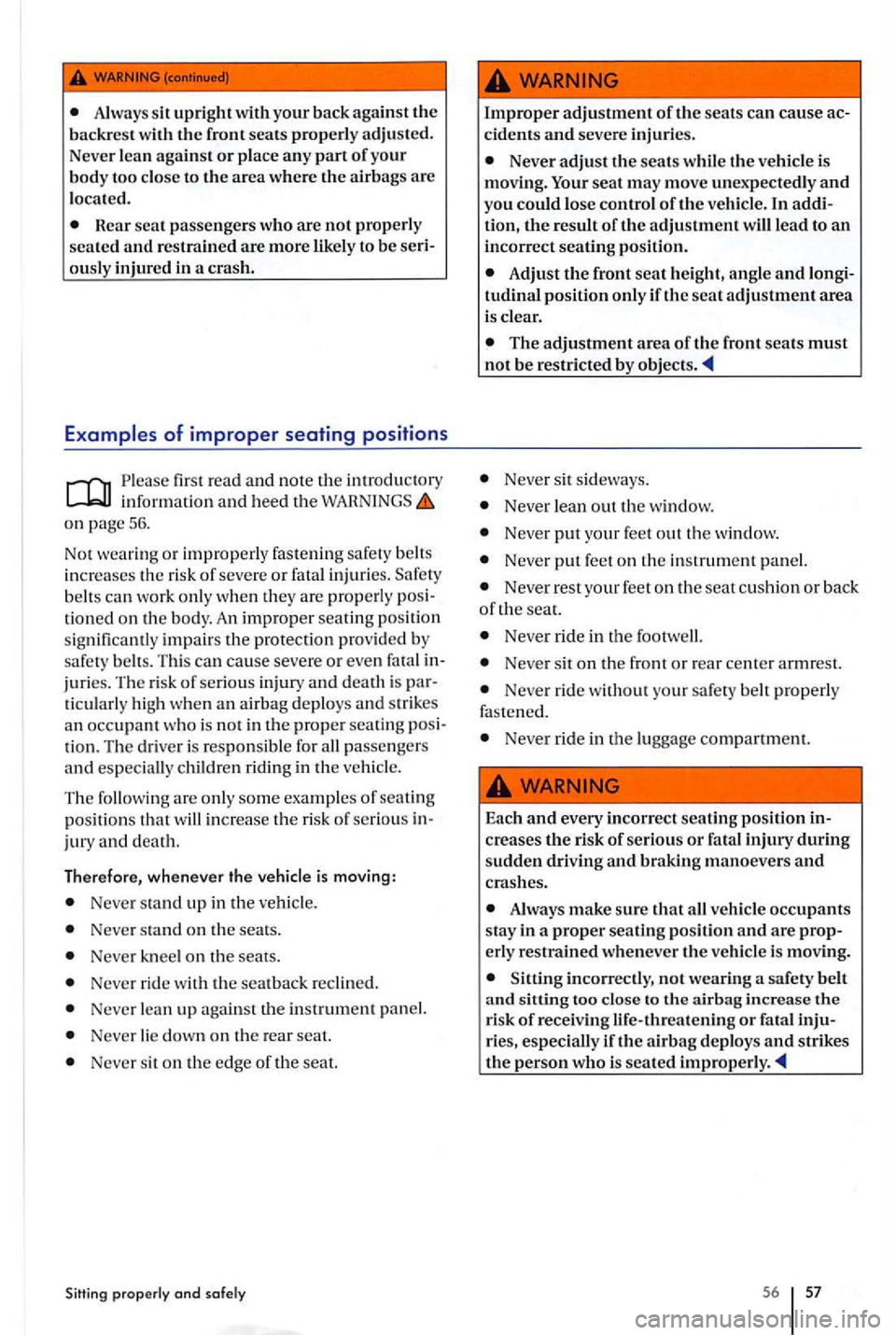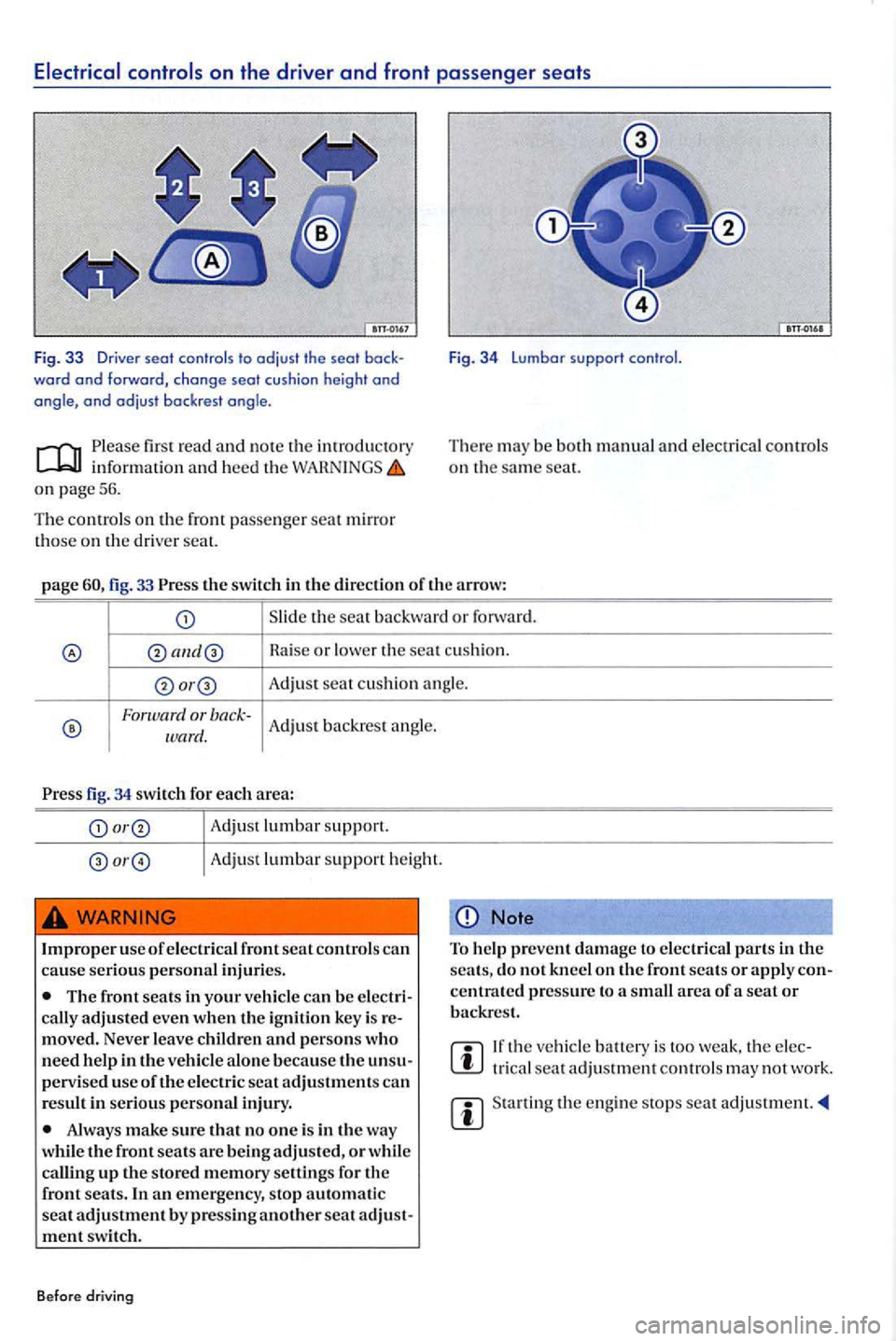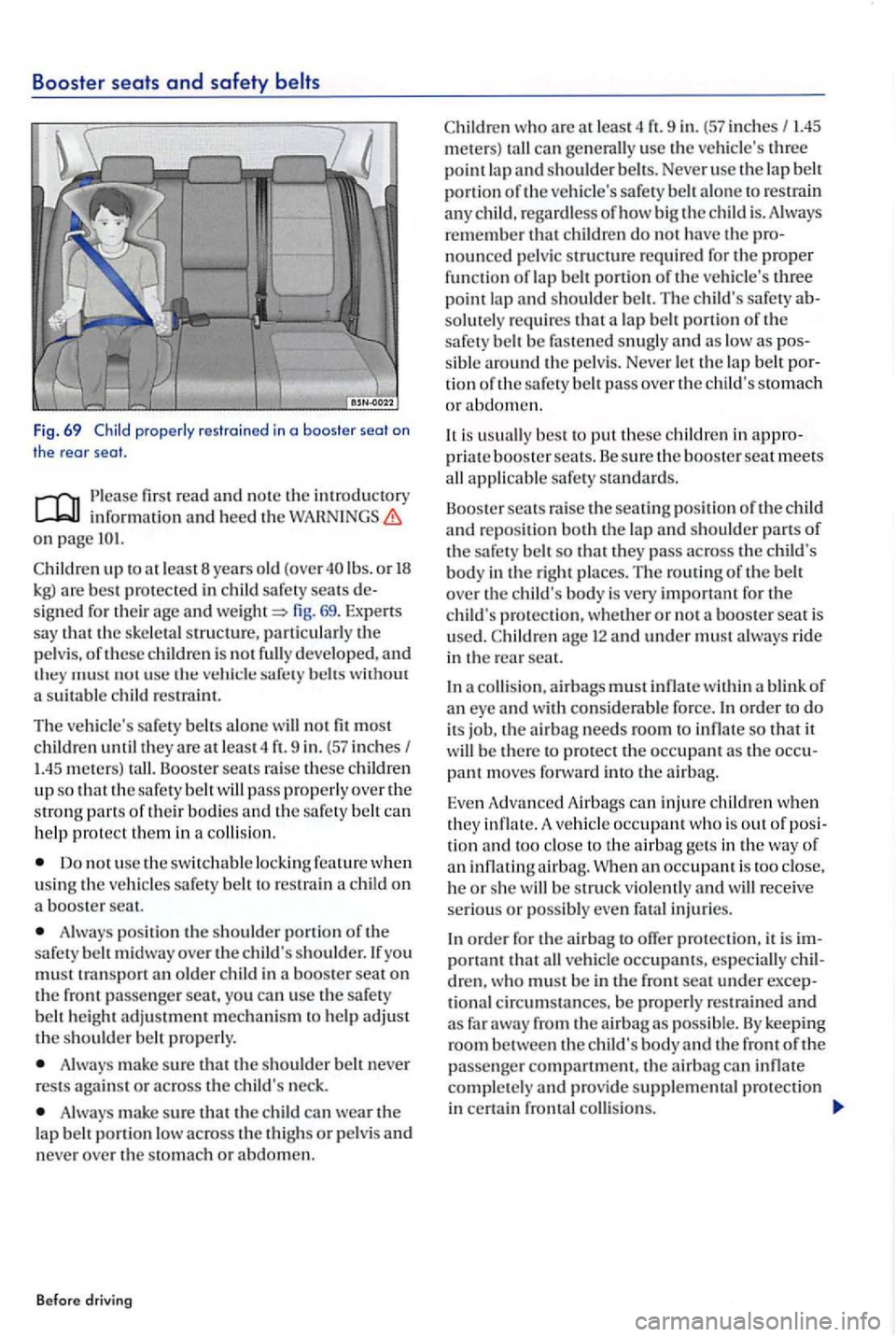2006 VOLKSWAGEN GOLF PLUS height adjustment
[x] Cancel search: height adjustmentPage 58 of 541

Always upright your back agains t the backrest with the front seats properly adjusted.
Never lean agains t or pla ce any part of you r
body too close to the area where the airb ags are
l oca ted.
Rear seat passengers who are not properly
seated and restrained are more lik ely to be seri
ously injured in a crash.
of improper seating positions
first r ead and not e th e introdu ctory inf ormation and hee d th e on pa ge 56.
Not w earin g or improperly fastening safety belts
i n c reases the risk of se ver e or fata l injuri es. Safe ty
b elt s can work onl y when they are prop erly po sitioned on th e bo dy. A n improp er se atin g pos ition
s ig nifi cantly impai rs the protection provided by
safety belt s. Thi s can cause se ve re or ev en fa ta l in
j uries. T he risk of se rious injur y and d eath is pa r
ti cularly hi gh wh en an airbag depl oys and strik es
an occupant who is not in the prop er seatin g pos i
ti o n. Th e driver is respons ibl e fo r pa ssen ge rs
a nd especi ally childr en riding th e vehicl e.
Th e
and dea th.
Therefore, whenever the vehicle
is moving :
Never stand up in the v ehicle .
Never stand on the seats.
Never kneel o n th e se ats.
Neve r rid e w ith the seat back re clin ed .
Neve r lea n up again st t he in strum ent pa nel.
Neve r lie dow n on the rear seat.
Neve r sit on th e edge of th e se at.
Sitting properly and safely
Improper adjustment of the seats can cause ac
cidents and severe injuries.
Never adjust the seats while the veh icle is
moving. seat may move unexpec tedly and
yo u could lose contro l of the vehicle. In addi
tion, the result of the adjustment will lead to an incorrect seating position.
Adjust the front seat height, angle and longi
tudinal position only if the seat adjustment area is clear.
The adjustment area of the front seats must not be restricted by ob jects
Nev er sit side ways.
N ever lean out the w indow.
Neve r put your feet o ut the window.
Never put feet on th e instrum ent panel.
Neve r rest your feet on the s eat cushion or b ac k of the seat.
Never rid e in the foo t well.
Neve r sit on th e front o r rea r ce nter armrest.
Neve r rid e withou t your belt prop erl y faste ned.
N ev er ride in th e lu gg age compartment.
Each
and incorrec t seating position in
creases the risk of seri o us or fatal during sudden driving and brakin g manoevers and cras hes.
Always make sure that all vehicle occupants
stay in a proper seat ing position and are prop
erly restrained whenever the vehicle is moving.
incorrec tly, not wearing a safety belt and sittin g too close to the airbag increas e the risk of receiving life-threatening or fatal inju
r ies, especially if the airbag deploys and strikes the person who is seated improperly
56 57
Page 61 of 541

word and forward , change seat cushion height and angle, and adjust backrest angle.
first r ead and note the inf orm atio n and hee d t he WAH N INGS on pag e 56.
T he co ntrols
on f ront passe nge r seat mi rro r on th e driver se at.
F ig. 34 Lumbar su pport control.
T he re m ay be bo th manual and e lectri ca l controls
o n th e sa me seat.
page fig. 33 th e sw itch i n th e d irec tion of th e a rrow:
Slid e th e seat b ackwa rd or forw ard .
Haise or l owe r th e seat cu sh io n .
Adjust sea t c u shi on an gle .
Forw ard or bac k-Adju st b ack res t an gle. ward.
fig. 34 switch f or each area:
Adju st lumbar s upport .
Adjust l umb ar suppo rt heig ht.
WARNING
Im prope r use of e lec tr ica l front sea t control s ca n cause serio us pe rso nal inju ries.
T he front sea ts in your vehicl e ca n b e
moved. Neve r leave children and p erso ns w ho
need h elp in the ve hicl e alo ne beca use the p erv ise d u se oftheelec tric sea t adjustments can
re sult in seriou s personal inju ry.
way
w hil e the front seats are bein g adju ste d, o r w hil e
ca llin g up sto re d m em ory settings for the
fr ont seats . In an em erge ncy, sto p aut om atic
seal adjustment b y pre ss ing a nother seat
N ote
T o help prev ent damage t o e lec trical p arts in the
s ea ts , do no t kn eel o n the front seals o r a ppl y
tr ica l seat adju stm ent contro ls m ay not w ork.
th e e ng in e s to p s se at
Page 75 of 541

Safety belt position
Fig . 52 Proper
informatio n on
Wea ring safe ty improperly ca n ca use serious
in jury or death. belt s ca n onl y work when they are corr ectly positioned on the body. A worn safe ty be lt also he lp s to position the cupant so that an airb ag can prov ide m aximum protection when deployed. Therefore, always
fasten your safe ty mak e sure that it is properly positioned over your body.
seati ng positi ons reduce the ness of safety jury or death by moving the sa fe ty to critica l
a re as of the body.
Before driving
safety belt position
The sho uld er portio n of the safe ty belt mu st ways run over the cen te r of the shoulder and neve r
ove r the th roat. ove r the arm. under the arm or hin d th e back.
The lap po rtion of the safety mus t ru n ove r th e pelv is a nd neve r over the abdomen.
Always wear th e safe ty a nd snug on the safe ty belt to tight en
if necessary .
Expectant mothers must a lways wear th e lap as low as possible across the pelv is an d below the rounding of the abdomen
throu ghout the pregnancy. The safe ty must lie aga inst th e bod y to avoid pressure against th e abdomen 53.
Adjusting safety belt height
Th e safety posit ion can be adjuste d u sin g the features:
belt he ig ht adju ster s for the front seats.
Fro nt seats with height adjustment.
rio us personal injury in an accident or a sudden braking maneuver.
belt s offer optimum protection onl y when th e seat bac k i s upright and belt s arc rectl y positioned on the body.
A safety belt can cause serious injuries by s hiftjn g its position on your body from the strong bones to more vulnerable s oft
tissu e and cause se riou s injury.
Page 113 of 541

Booster seat s and safety belts
Fig . 69 properly res train ed in a booster se a l on the rear seal.
fir st r ead and note the introductory info rmati on and heed th e on page
sign ed th eir age and fig. 69. E xp ert s
s a y that the sk e le ta l s tructure, parti cu larl y the
p e lv is,
b elt s w ithout a suitabl e child restra int.
Th e ve hicl
e's safety be lts al one will not fit most
children until th ey are atleast4
or their bodi es and the safety be lt can h elp protect them in a c ollision.
Do no t use the switchable lo cking feature wh en
u sin g the ve hicle s s afet y belt to res train a child on a booste r se at.
Alw ays pos ition the should er p o rt ion belt midway over the c hild's sh oulder. you mus t tra n sp o rt an old e r child in a b ooster seat on the front passe nge r seat. yo u can use th e safety
b elt height adjustment mechanis m t o help adjust the s ho uld er b elt properly.
A lw ays make sure tha t the s ho uld er b elt never res ts against o r across the c hild's neck.
A lways
w ho are at least4 ft. 9 in. (57 in ches I 1.45
m ete rs) tall can ge nerall y use th e ve hicle's three
p o int lap and sh ould er b elt s. Neve r use the lap belt portion of the ve hicl e's s afet y belt alo ne to restrain any c hild, regardless of how bi g the c hild is . Alw ays remembe r that childr en do n o t h ave the nounced pe lv ic s tru ctur e re quired fo r the proper fun ctio n of lap belt po rti on of th e ve hicle's three po int la p and s houlder b elt. The c hild's safet y solutely requires that a la p b elt po rti on of th e
safe ty belt be faste n ed snugly and a s low as
tion the safety belt pa ss ove r th e child's stomach
or abdomen.
la p and sh o ulder parts of th e safe ty belt so that they pass across the c hild's body in the right places. The routin g of the be lt
o ve r the c hild's bo dy is very important fo r the child's protectio n, w hether or not booste r seat is
u se d. age 12 and under must ride
in the rear seat.
In a co
llisio n, airbags must infl ate w ithin a blink of an eye and w ith considerabl e fo rce. ord er to do its job, the airbag needs room t o inflat e so that it
w ill be there to protect the occupant as the
tio n and too close to the airba g gets in the wa y of an inflatin gairbag. Wh en an occupant is to o close ,
h e or sh e will b e s tru ck viol entl y and will recei ve seri ous o r possibly eve n fatal injurie s.
orde r
tional c ir cumstances , be pro pe rly restrained and as far aw ay from the a irbag as possib le. B y keepin g
ro om b etwee n the child's bo d y and th e front o f the passenge r compartm ent, the air b ag can infl ate compl ete ly and provide s u ppl em ental protectio n
in certain frontal collis io ns.